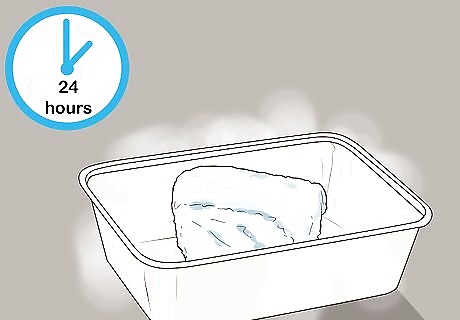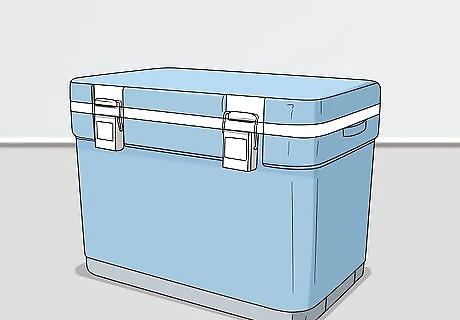
views
Letting Dry Ice Sublimate

Wear insulated gloves to handle dry ice. On contact, dry ice can harm your skin. After touching dry ice for a few seconds, you may experience burns or frostbite to the exposed skin. Never touch dry ice without wearing insulated gloves that will create a suitable barrier between your hands and the ice. In a pinch, oven mitts or winter gloves are suitable for handling dry ice for a few seconds at a time. Nitrile exam gloves will not provide you any significant protection against dry ice. Use tongs to handle dry ice when possible.

Place dry ice in an open, well-ventilated area to sublimate. When left at any temperature under −109 °F (−78 °C), dry ice will transform from a solid to a gas. Place the dry ice in a well-ventilated space so that the carbon dioxide gas will disperse without causing harm to anyone. Keep the dry ice on a piece of styrofoam or hard plastic so that it won't harm your floor. For instance, leave dry ice in a large room with open windows or on a secure balcony. If possible, choose an area that you do not spend a lot of time in to avoid exposure to carbon dioxide gas. Never place dry ice directly on a tiled or solid surface countertop as the extreme cold will damage it.

Let the dry ice sit for at least 1 day until it is completely sublimated. Depending on the volume of dry ice you have, it may take several days for it to completely revert to a gaseous form. Let the dry ice sit out in a well-ventilated area for 1 full day, then check on it to see if it has sublimated yet. Avoid spending too much time in this area to minimize your exposure to the carbon dioxide gas being released. As a general rule, it takes about 24 hours for 10 pounds (160 oz) of dry ice to fully sublimate. Blocks of dry ice will take longer to sublimate than pellets or flakes.
Avoiding Problems

Do not dispose of dry ice in areas accessible to the general public. Leaving dry ice in a shared hallway or other public areas will put others at risk of contact burns with the substance. It may also cause a build-up of carbon dioxide, creating an oxygen-deficient atmosphere. Always store or dispose of carbon dioxide somewhere inaccessible to the public. Make sure animals can't get to dry ice when you get rid of it, as they may experience contact burns from it.

Never dump dry ice into the trash or down a garbage chute. Dry ice needs to sublimate or evaporate in a well-ventilated area. A build-up of carbon dioxide vapor in a confined space could lead to an explosion, making it very dangerous. Always avoid disposing of dry ice in a garbage can, dumpster, or down a building's garbage chute. An explosion could result in personal injury or property damage.

Do not flush dry ice or try to wash it down a sink. The extreme cold emitted by dry ice can harm your toilet parts and pipes. Avoid trying to dispose of it in the sink as you might regular ice, which melts easily. Similarly, flushing dry ice down the toilet may seem like a fast and easy way to get rid of it, but you will likely cause lasting damage to your plumbing system if you do so.

Store dry ice in containers that allow the release of carbon dioxide gas. Before disposing of it, avoid keeping dry ice in any sealed container that is not specified for the storage of dry ice. These containers include styrofoam dry ice mailing containers and insulated dry ice storage containers. Purchase these from a shipping company or online from scientific equipment retailers. Containers that are not specified for dry ice storage will not have the right insulation or ventilation to store dry ice safely. Styrofoam is a suitable storage material for dry ice since it is insulated but not airtight.

Keep dry ice in the trunk if you are transporting it in your vehicle. The carbon dioxide released from dry ice can quickly fill up the cabin of a small passenger vehicle. This may cause the driver to feel ill or disoriented, increasing the risk of an accident. Always secure dry ice in the trunk of your vehicle if you have to transport it by car. Avoid transporting dry ice over long distances.



















Comments
0 comment